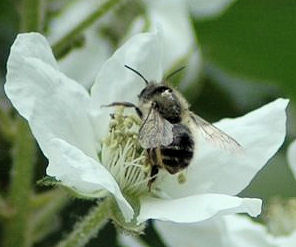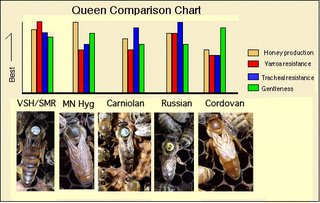When I bought my first tow nuclear hives I specified Hygienic Golden Italian Bees. These are beautiful golden brown bees that produce large amounts of honey and are docile and not prone to sting. The Hygienic part of the name refers to a breed of Italian that are very good at identifying sick young bees and preventing the disease from spreading. These are a good bee for a beginner like me.
I took a picture of my bees pollinating the wild blackberry bushes.
As you can see the bee is not gold colored. It is a dark brown. I thought that it might be the light or else it belonged to someone else.
I was watching my hives this weekend and decided that the “Ethel” hive has changed race. It is definitely a brown Russian colony now.
How can this happen?
The hive was verified Italian when I bought it. The Apiary makes nucs by taking five good frames from a large hive and introducing a new queen. They must have accidentally put a Russian queen into the Italian nuc. Another scenario might be that the original Italian queen died and the hive made a new queen that mated with a Russian drone. That would make my hive a half Italian, half Russian crossbreed, which might explain its belligerence. Hybrids are often not very friendly.
Bees aren’t concerned at all with race. A hive can have half of the brood one race, half another and a different race for the queen and it makes no nevermind. It takes 21 days from egg to bee, and the young bees stay inside the hive for two weeks. It takes about 5 weeks before you notice that the race has changed. I bought these bees on April 19 and I am just now noticing that they are all dark brown, which is about right.
I took some pictures of the golden bees, but the camera fought back. I will try again and cross post to my bee progress blog.

(on this chart Hygenic Golden Italians are listed as MN Hyg because they are also know as University of Minnesota Hygenics.)
One Comment
I hope you don’t have a stray killer bee queen in there!